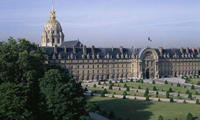 Waterloo to Sedan: beaten but unbowed
Waterloo to Sedan: beaten but unbowedMusée de l’Armée in Les Invalides opens 19th century galleries
By Anna Sansom | Web only
Published online 17 Feb 10 (Museums)
La Invalides (Photo: Musee de l'Armee - Paris)
paris. The Musée de l’Armée in Paris will open galleries on 20 March that cover the years from 1815 to 1870, and so two of the biggest defeats in the French Army’s history: Waterloo and Sedan. The museum says that it has sought to present these defeats as objectively as possible. “We are a history museum and not one on French ideology,” says Emilie Robbe, the curator of the museum’s modern department, explaining that the section on the Franco-Prussian War draws a comparison between the strengths and weaknesses of the two sides at the Battle of Sedan, and the war’s causes and consequences.
“We have sought to give a more pedagogical approach to emphasise the system of defence and engagement of the nation in the army,” says Robbe. “Before the emphasis was more on objects, with an assumption that visitors knew about the history of France. The new focus allows us to talk to a larger public that is not just French, but English, German and Japanese-speaking.”
The Musée de l’Armée is situated in the complex of buildings at Les Invalides and was founded in 1905, assembling the former artillery museum created in 1871 and the historical museum of the army created in 1896. It houses Napoleon Bonaparte’s tomb and traces the history of France’s army from the Middle Ages to the 20th century. Rooms on the two World Wars reopened following renovations in 2006, while an information space devoted to Charles de Gaulle was inaugurated by French president Nicolas Sarkozy in February 2008. The €16.8m modernisation of France’s army museum began in 2003—chiefly financed by the defence ministry and the museum.
Over the past seven years, different spaces in the museum have been closed, renovated and reopened in successive stages. The rooms housing the first part of the modern department dating from the reign of Louis XIV to Napoleon I (1643-1814) opened on the first floor in May 2009 in the presence of defence minister Hervé Morin.
The highlights include Charles I’s ceremonial black velvet coat, the red velvet, richly adorned saddle that Napoleon II used at the Battle of Magenta, and the cannonball-blasted breastplate worn by François-Antoine Fauveau, a soldier who died at the Battle of Waterloo.
Also reopening on 20 March are two former ground-floor refectories for the Hôtel des Invalides, previously a residence for wounded soldiers and veterans. Both are decorated with mural paintings made from 1677-78 by Jacques Antoine Friquet de Vauroze, depicting battle scenes of the War of Devolution (1667-68) between France and Spain over possession of the Spanish Netherlands (present-day Belgium and Luxembourg). The restoration of the murals, directed by Madeleine Hanaire, was completed in December 2009.
One of the refectories, Salle Turenne, will evoke the manner in which former soldiers had meals there. The other, Salle Vauban, will feature a cortège of 13 cavalrymen on horses symbolising different periods from the Consulate of France (1799-1804), which ended at the start of the Napoleonic Empire, to the Second Empire (1852-70). Some of the cavalrymen were painted by the 19th-century battle painters Ernest Meissonier and Édouard Detaille in homage to the French army’s history.
 Waterloo to Sedan: beaten but unbowed
Waterloo to Sedan: beaten but unbowed